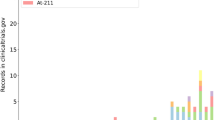Abstract
To establish and validate a method for cell irradiation in 96-well and 6-well plates using a linear accelerator, three irradiation methods (G0B0F40, G0B1.5F40, and G180B1.5F40) were designed to irradiate cell culture plasticware simulated with RW3 slab phantom and polystyrene. The difference between the actual physical measured dose and the preset dose was compared among the three methods under the preparatory conditions of 2, 4, 6, 8, and 10 Gy. MDA-MB-231 cells were analyzed by using a cell proliferation assay and a clonogenic assay to verify the difference between the three cell irradiation methods on cell radiosensitivity. For each preset dose, the difference between the actual measured dose and the preset dose was the lowest for Method G0B1.5F40, the second lowest for Method G180B1.5F40, and the maximum for Method G0B0F40. The ranges of the differences were − 0.28 to 0.02%, − 2.17 to − 1.80%, and − 4.92 to − 4.55%, and 0.31 to − 0.12%, − 3.42 to − 2.86%, and − 7.31 to − 6.92%, respectively, for 96-well and 6-well plates. The cell culture experiments proved that Method G0B1.5F40 was an accurate, effective, simple, and practical irradiation method. The most accurate and effective cell irradiation method should always be used, as it will reduce dose differences and instability factors and provide improved accuracy and comparability for laboratories researching cellular radiosensitivity.



Similar content being viewed by others
Change history
11 April 2018
In the original publication, Figure 2c is incorrectly published. The correct figure is provided in this correction article.
References
J.Y. Lang, P. Wang, D.K. Wu et al., An investigation of the basic situation of radiotherapy in mainland China in 2015. Chin. J. Radiat. Oncol. 5, 541–545 (2016). https://doi.org/10.3760/cma.j.issn.1004-4221.2016.06.001
D.J.M. Lamas, J.E. Cortina, C. Ventura et al., Enhancement of ionizing radiation response by histamine in vitro and in vivo in human breast cancer. Cancer Biol. Ther. 16, 137–148 (2015). https://doi.org/10.4161/15384047.2014.987091
H. Yu, X. Tang, D. Shu et al., Influence of neutron sources and 10B concentration on boron neutron capture therapy for shallow and deeper non-small cell lung cancer. Health Phys. 112, 258–265 (2017). https://doi.org/10.1097/HP.0000000000000601
H. Hojo, T. Dohmae, K. Hotta et al., Difference in the relative biological effectiveness and DNA damage repair processes in response to proton beam therapy according to the positions of the spread out Bragg peak. Radiat. Oncol. 12, 1–9 (2017). https://doi.org/10.1186/s13014-017-0849-1
S. Terashima, Y. Hosokawa, E. Tsuruga et al., Impact of time interval and dose rate on cell survival following low-dose fractionated exposures. J. Radiat. Res. 8, 1–9 (2017). https://doi.org/10.1093/jrr/rrx025
L. Van den Bosch, G. Defraene, S. Peeters et al., Is there a different dose-effect relation between the primary tumor and involved lymph nodes in locally advanced non-small-cell lung cancer? A hypothesis-generating study. Acta Oncol. 56, 541–547 (2017). https://doi.org/10.1080/0284186X.2017
S.G. Mikalsen, N.E. Jeppesen, J.A. Sandvik et al., Separation of two sub-groups with different DNA content after treatment of T-47D breast cancer cells with low dose-rate irradiation and intermittent hypoxia. Acta Radiol. 49, 1–9 (2017). https://doi.org/10.1177/0284185117699999
X.R. Yang. Study of Biological Effects and Proteomics on Breast Cancer Cells MDA-MB-231 Induced by X-ray Irradiation. Ph.D. Thesis, Lanzhou University (2016) (in Chinese)
Y.Y. Jin, Q.J. Chen, Y. Wei et al., Upregulation of microRNA-98 increases radiosensitivity in esophageal squamous cell carcinoma. J. Radiat. Res. 57, 468–476 (2016). https://doi.org/10.1093/jrr/rrw068
X.X. Chen. Clinical Analysis of Radiotherapy Effect and In Vitro Radiosensitivity Study for Triple Negative Breast Cancers. Ph.D. thesis, Fudan University Shanghai Cancer Center (2013) (in Chinese)
M.A. Zachari, P.S. Chondrou, S.E. Pouliliou et al., Evaluation of the ALAMARBLUE assay for adherent cell irradiation experiments. Dose-Response 12, 246–258 (2014). https://doi.org/10.2203/dose-response.13-024
H. Mozdarani, Z. Mansouri, S.A. Haeri, Cytogenetic radiosensitivity of G0-lymphocytes of breast and esophageal cancer patients as determined by micronucleus assay. J. Radiat. Res. 46, 111–116 (2005). https://doi.org/10.1269/jrr.46.111
B. Hu. Effect of miRNA-125b-1 on Radiosensitivity and on Chemosensitivity of SKBR-3 Breast Cancer Cells. Ph.D. thesis. Guangzhou, Southern Medical University (2009) (in Chinese)
Z.A. Zheng, X.G. Fu, F. Liu et al., Investigation of the radiation methods of the experimental cell on the linear accelerator. Chin. J. Biomed. Eng. 31, 781–784 (2012). https://doi.org/10.3969/j.issn.0258-8021.2012.05.020
B.D. Smedt, B. Vanderstraeten, N. Reynaert et al., The influence of air cavities within the PTV on Monte Carlo-based IMRT optimization. J. Phys.: Conf. Ser. 74, 012003 (2007). https://doi.org/10.1088/1742-6596/74/1/021003
J. Swanpalmer, K.A. Johansson, The effect of air cavity size in cylindrical ionization chambers on the measurements in high-energy radiotherapy photon beams—an experimental study. Phys. Med. Biol. 57, 4671–4681 (2012). https://doi.org/10.1088/0031-9155/57/14/4671
J.Z. Xiao, J.Y. Wang, D.J. Qian et al., Air cavity problems during radiation therapy with high energy X-rays. Chin. J. Radiat. Oncol. 3, 189–191 (1994)
S.T. Wang, Y.M. Hu, F. Wu, Cavity effect in the dose distribution on the inner surface of nasopharynx. Chin. J. Radiat. Oncol. 2, 122–123 (1992)
I. Abatzoglou, C.E. Zois, S. Pouliliou et al., Establishment and validation of a method for multi-dose irradiation of cells in 96-well microplates. Biochem. Biophys. Res. Commun. 431, 456–459 (2013). https://doi.org/10.1016/j.bbrc.2012.12.146
K.D. Mukhopadhyay, A. Bandyopadhyay, T.T.A. Chang et al., Isolation and characterization of a metastatic hybrid cell line generated by ER negative and ER positive breast cancer cells in mouse bone marrow. PLoS ONE 6, e20473 (2011). https://doi.org/10.1371/journal.pone.0020473
J.Y. Fang, S.-J. Tan, Y.C. Wu et al., From competency to dormancy: a 3D model to study cancer cells and drug responsiveness. J Transl. Med. 14, 1–13 (2016). https://doi.org/10.1186/s12967-016-0798-8
S. Fani, B. Kamalidehghan, K.M. Lo et al., Anticancer activity of a monobenzyltin complex C1 against MDA-MB-231 cells through induction of Apoptosis and inhibition of breast cancer stem cells. Sci. Rep. 6, 38992 (2016). https://doi.org/10.1038/srep38992
Author information
Authors and Affiliations
Corresponding author
Additional information
This work was supported by the Hospital Personnel Climbing Plan of the Tenth People’s Hospital Affiliated to Tongji University.
Rights and permissions
About this article
Cite this article
Dong, XQ., Lin, Q., Hu, J. et al. Establishment and validation of a method for cell irradiation in 96-well and 6-well plates using a linear accelerator. NUCL SCI TECH 29, 67 (2018). https://doi.org/10.1007/s41365-018-0407-z
Received:
Revised:
Accepted:
Published:
DOI: https://doi.org/10.1007/s41365-018-0407-z




